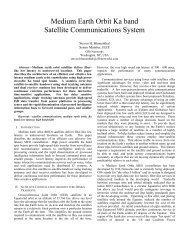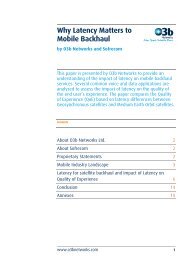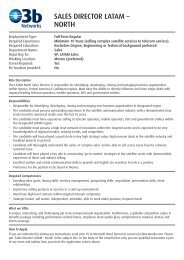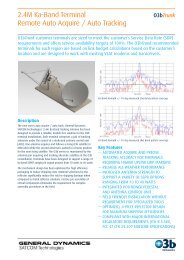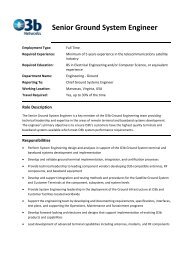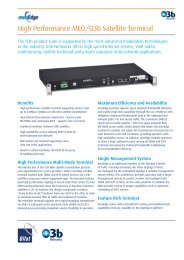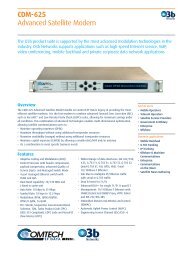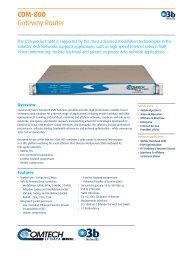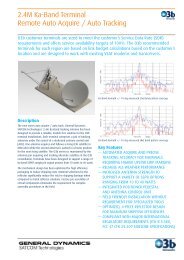Why Latency Matters to Mobile Backhaul - O3b Networks
Why Latency Matters to Mobile Backhaul - O3b Networks
Why Latency Matters to Mobile Backhaul - O3b Networks
Create successful ePaper yourself
Turn your PDF publications into a flip-book with our unique Google optimized e-Paper software.
<strong>Why</strong> <strong>Latency</strong> <strong>Matters</strong> <strong>to</strong> <strong>Mobile</strong> <strong>Backhaul</strong><br />
The increase in latency of 420ms between <strong>O3b</strong>’s MEO solution and a GEO<br />
satellite has a significant impact on interactive services.<br />
As demonstrated, revenue loss is a significant consequence of the quality<br />
degradation of a users’ experience caused by download delays. End users<br />
perceive latency increases of a few hundred milliseconds in a negative<br />
way, which translates in<strong>to</strong> a loss of business for providers and advertisers.<br />
Users are unaware whether the delay in response time is due <strong>to</strong> a slow<br />
server or a satellite link. The end result in both cases is the same: a poor<br />
user Quality of Experience.<br />
TCP in a nutshell<br />
The Internet uses the Transmission Control Pro<strong>to</strong>col (TCP) <strong>to</strong> provide end-<strong>to</strong>end<br />
services. In particular, TCP ensures the error free sequenced delivery of<br />
data transmitted from a source <strong>to</strong> a destination.<br />
Data is sent by the transmitter <strong>to</strong> the receiver in fragments called TCP<br />
segments. A maximum size is defined for the segments. The receiver will<br />
confirm the correct reception of sent TCP segments by acknowledging them<br />
(sending the transmitter a response “ACK message” with a correct<br />
sequence number). If an ACK message is not received or if it is not correct,<br />
the transmitter will return the message ensuring a reliable transfer. At the<br />
end of the session, it is correctly closed by exchange of FIN messages.<br />
The key fac<strong>to</strong>r in this context is that TCP will only send a limited amount of<br />
data before it needs an acknowledgement. The amount of data is governed<br />
by the TCP buffer size, which in Windows 7 is 64 kbytes. If 64 kbytes of<br />
data has been sent but the acknowledgements have not yet been received,<br />
TCP will wait for an acknowledgement before it sends another packet. This<br />
acknowledgement mechanism is what limits the transmission rate over<br />
high latency links.<br />
Non interactive data services<br />
The major complexity of TCP comes from its flow and congestion control<br />
mechanisms. The TCP flow control mechanism adjusts the TCP window size<br />
(the number of segments that can be sent and not yet be acknowledged)<br />
depending on the status of the end devices and congestion/latency on the<br />
link during the transfer.<br />
www.o3bnetworks.com 11



